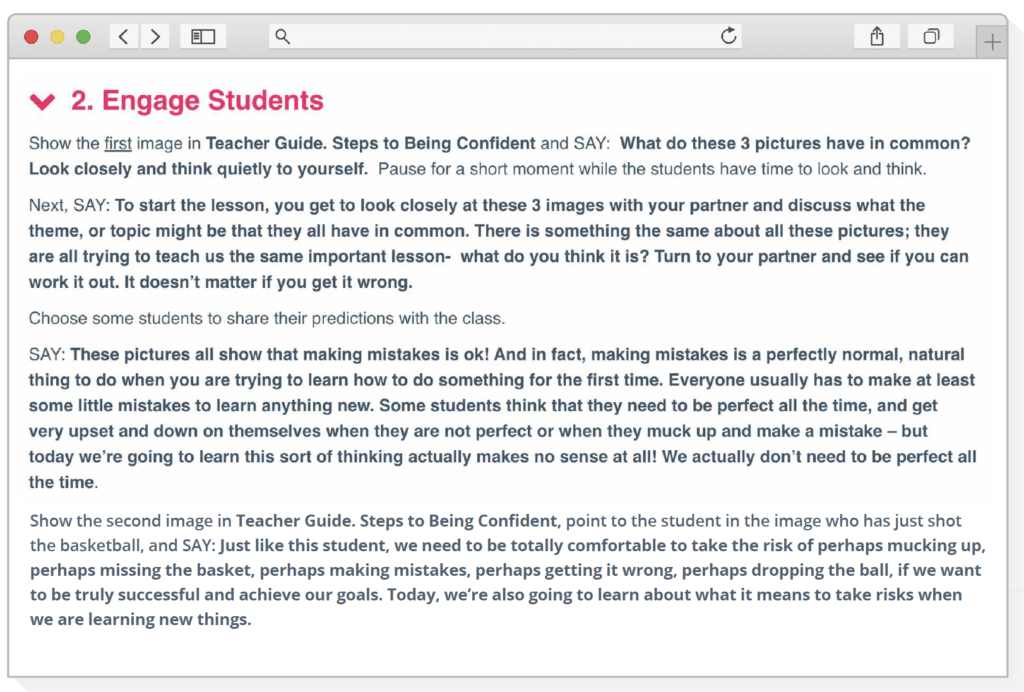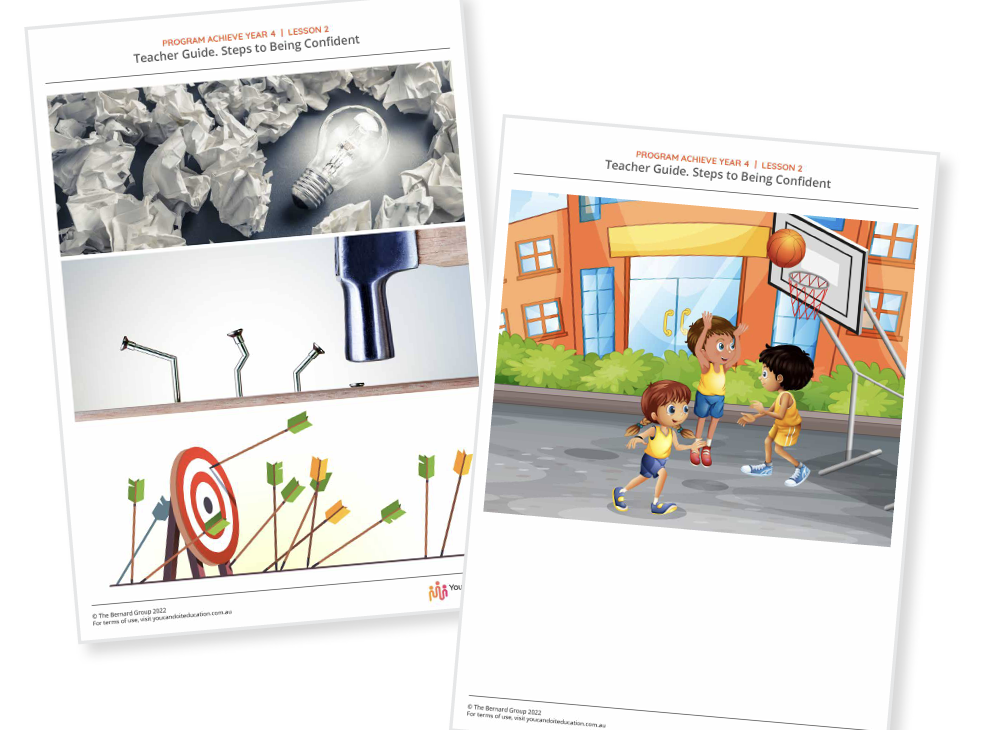Lessons in Program Achieve help students to perceive, interpret and evaluate reality in level-headed, non-extreme ways, positively affecting their thinking, emotions and behaviours. Learning rational beliefs (e.g. self-acceptance, risk-taking, independence, growth mindset, high frustration tolerance, acceptance of others) helps students of all ages emotionally cope when encountering life’s stressors. Program Achieve ultimately guides students to acquire the self-belief to handle stressful situations or difficult people without always needing the help of others. As a result, students learn to self-regulate their Amygdala activation and retain the use of their Pre-Frontal Cortex.
In Program Achieve, two powerful tools, the Catastrophe Scale and the Emotional Thermometer, help students re-evaluate how ‘bad’ an event is, lowering their emotional intensity and boosting their rational thinking.
Students also learn different mindfulness techniques, such as breathing, meditation and yoga, which help to calm the Amygdala and increase emotional regulation in times of stress, anger or anxiety.
BRAIN-BASED, SOCIAL-EMOTIONAL
LEARNING IN YOU CAN DO IT!
EDUCATION
When students repeat, revise and recall any given thought, action, skill or piece of knowledge, that particular neural pathway becomes stronger, well-worn, familiar and dominant. In doing so, the electrical impulses can travel that pathway faster and more powerfully. When t is occurs, students have formed a memory.
Program Achieve lessons revise and build on fundamental topics in an increasingly complex fashion from Year 1 to Year 10. Each lesson begins with a brief ‘Review Previous Lesson Challenge’ section before the new lesson builds on this prior knowledge. The lessons within a term cover different components of the same social-emotional skills, allowing for continuous revision and elaboration over eight weeks. Lessons include previously learnt knowledge and skills so students can link to their prior knowledge. A range of effective repetition and re-coding activities in various learning modes are spread throughout the lessons, including reading, writing, discussing, role-playing, drawing and more. Importantly, each lesson ends with a Goal Setting Challenge to encourage the topic to be remembered and practised throughout the week.
These repetitive components mean that students can form stronger neural pathways, creating solid memories of the skills and content taught in Program Achieve.
PRODUCING ESSENTIAL MESSENGER
CHEMICALS
Program Achieve lessons include a range of engaging and effective learning strategies to help students’ brains create the essential neurotransmitters or messenger chemicals needed for enhanced learning and improved memory formation.
At the very beginning of every lesson, particularly in the Engage Students section of the Lesson Plan, you will find various visually stimulating images, props, and discussion prompts to hook students’ attention, arouse their curiosity and thus release Dopamine. Lessons involve strategies for students to understand the topic’s relevance and realise it is meaningful and beneficial to them (creating Acetylcholine), helping focus their attention.
Age-appropriate, relatively demanding aspects of every lesson, such as timed activities, involve students exerting effort (producing Epinephrine) to complete challenging tasks.
THE AMYGDALA AND THE PREFRONTAL
CORTEX (PFC)
You Can Do It! Education focuses on understanding how students’ observable ‘external’ behaviour (what they say and do) is caused by unseen ‘internal’ mental events: how students feel and think (self-talk). Professor Bernard has discovered that at the core of student mindset are a set of positive and negative attitudes – or rational and irrational beliefs. Program Achieve focuses on helping young people to become aware of and change their negative attitudes into positive ones, which is a role of the PFC. Learning to change their attitudes does a lot to help students promote positive rather than negative self-talk, feelings and behaviours and can prevent or reduce emotional and behavioural difficulties.
To this end, Program Achieve lessons teach students the power of 12 positive attitudes, including rational ways to think (self-talk), which strengthen the five key social-emotional skills. These SELs, when used together, result in less activation of the amygdala and aid retention of the pre-frontal cortex capabilities when stressful events occur.
Using repetition and revision, students progressively and repeatedly practice these 12 Positive Attitudes (and become aware of their 12 negative opposites) so helpful ways of thinking can become automatic. Students can apply them when bad things happen without needing to be reminded. Program Achieve ultimately guides students to acquire the self-belief to handle stressful situations or difficult people without always needing the help of others.
The lessons help students perceive, interpret and evaluate reality in level-headed, moderate, non-extreme ways, positively affecting their thinking, emotions and behaviours – so that they are not extreme or self-defeating. These rational beliefs (e.g. self-acceptance, risk-taking, being independent, growth mindset, high frustration tolerance, acceptance of others) help students of all ages to emotionally cope when faced with life’s stressors.
As a result, Program Achieve, by teaching students how to change the way their mind thinks, helps them to self-regulate their amygdala activation and retain the use of their pre-frontal cortex.
Resiliency is particularly important, and a core SEL skill taught in YCDI!’s Program Achieve. From a brain-science perspective, resilience is an essential skill that allows us to retain the use of our pre-frontal cortex when bad events occur by preventing the amygdala from being activated (or at least to prevent it from becoming intensely activated) and shutting down our ability to think, learn and problem solve.
Resilience includes developing an inner ability to rebound quickly and calm our brain even after a highly negative response to an event by using strategies to switch off an activated amygdala and regain the use of the pre-frontal cortex.
THE MIRROR-NEURON EFFECT
Teachers must be excited, positive, and genuinely ‘on board’ with the importance of social-emotional learning when presenting lessons from Program Achieve. As teachers, our emotions and attitudes towards the lessons we teach are quite literally contagious due to a phenomenon called the Mirror Neuron Effect. To increase staff ‘buyin’ and enthusiasm, have teachers participate in You Can Do It! Professional Development sessions to learn more about the incredible importance and benefits of social-emotional learning and the various components of Program Achieve. Increasing teachers’ enthusiasm for and genuine interest in teaching the topics in Program Achieve will mean students’ brains will mirror their positive emotions about the lessons.
As a school-wide community, students, parents and teachers should learn the relevance of social-emotional learning by understanding the bigger picture goal behind You Can Do It! Education is to help students be successful and happy in school and life, academically and from a wellbeing perspective.






